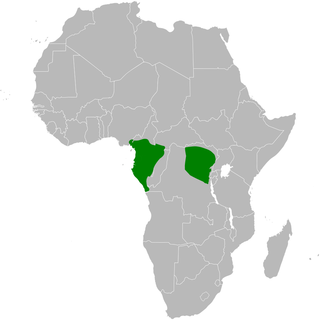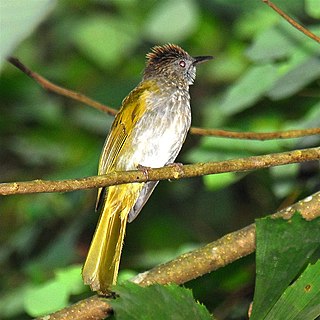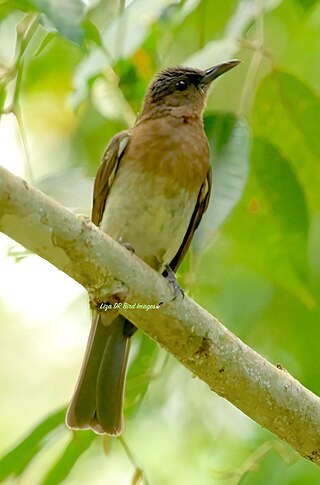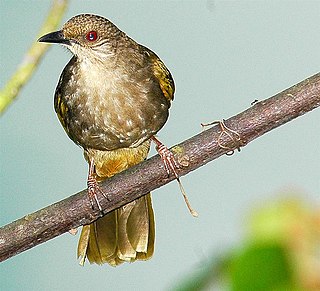
The bulbuls are members of a family, Pycnonotidae, of medium-sized passerine songbirds, which also includes greenbuls, brownbuls, leafloves, and bristlebills. The family is distributed across most of Africa and into the Middle East, tropical Asia to Indonesia, and north as far as Japan. A few insular species occur on the tropical islands of the Indian Ocean. There are 166 species in 32 genera. While different species are found in a wide range of habitats, the African species are predominantly found in rainforest, whereas Asian bulbuls are predominantly found in more open areas.

The Seram golden bulbul is a species of songbird in the family Pycnonotidae. It is endemic to the Moluccas. Until recently, it was considered conspecific with the northern golden bulbul and the Buru golden bulbul. Its natural habitat is subtropical or tropical moist lowland forests.

Alophoixus is a genus of songbird in the bulbul family, Pycnonotidae found in south-eastern Asia.

The honeyguide greenbul is a species of songbird in the bulbul family, Pycnonotidae. It is widespread throughout the African tropical rainforest.

Criniger is a genus of songbirds in the bulbul family, Pycnonotidae. The species of Criniger are found in western and central Africa.

The eastern bearded greenbul is a species of songbird in the bulbul family, Pycnonotidae. It is found from south-eastern Nigeria to Central African Republic, north-eastern Democratic Republic of the Congo, Congo and extreme north-western Angola. Its natural habitats are subtropical or tropical moist lowland forests and subtropical or tropical moist montane forests.

Hemixos is a songbird genus in the bulbul family, Pycnonotidae.

The mountain bulbul is a songbird species in the bulbul family, Pycnonotidae. It is often placed in Hypsipetes, but seems to be closer to the type species of the genus Ixos, the Sunda bulbul. It is found in Southeast Asia and is not considered a threatened species by the IUCN. It is named after British East India Company Surgeon John McClelland.
The Nicobar bulbul is a songbird species in the bulbul family, Pycnonotidae. It is endemic to the Nicobar Islands. This species has sometimes been placed in the genus Ixos.

The Javan bulbul is a songbird species in the bulbul family. It is the type species of the genus Ixos. It is endemic to the island of Java in Indonesia in its natural habitat of subtropical or tropical moist montane forests. It is not considered a threatened species by the IUCN.

Ixos is a genus of passerine birds in the bulbul family, Pycnonotidae.

The streaked bulbul, or green-backed bulbul, is a songbird species in the bulbul family (Pycnonotidae). It is found on the Malay Peninsula, Sumatra, and Borneo. Its natural habitat is subtropical or tropical moist lowland forests. It is becoming rare due to habitat loss.

The sulphur-bellied bulbul is a songbird species in the bulbul family, Pycnonotidae. It is endemic to Palawan (Philippines). Its natural habitat is tropical moist lowland forests.

The Zamboanga bulbul is a songbird species in the bulbul family, Pycnonotidae. It is endemic to the Philippines, where its natural habitat is tropical moist lowland forests of Basilan and the Zamboanga Peninsula. It is becoming rare due to habitat loss.

The streak-breasted bulbul is a songbird species in the bulbul family, Pycnonotidae.

Pycnonotus is a genus of frugivorous passerine birds in the bulbul family Pycnonotidae.

The hook-billed bulbul is a species of songbird in the bulbul family, Pycnonotidae. It is found in eastern Sumatra and Borneo, where its natural habitats are subtropical or tropical moist lowland forest and subtropical or tropical swamps. It is threatened by habitat loss. Alternate names for the hook-billed bulbul include the long hook-billed bulbul and long-billed bulbul.

Iole is a genus of songbirds in the bulbul family, Pycnonotidae. They are native to tropical eastern Asia, from India to China and south through Southeast Asia to northern Indonesia.
Microscelis is a former genus of bulbuls described by George Robert Gray in 1840.
The Sula golden bulbul is a species of songbird in the bulbul family Pycnonotidae. It is endemic to Sula Island in the Philippines. Its natural habitat is subtropical or tropical moist lowland forests.

















